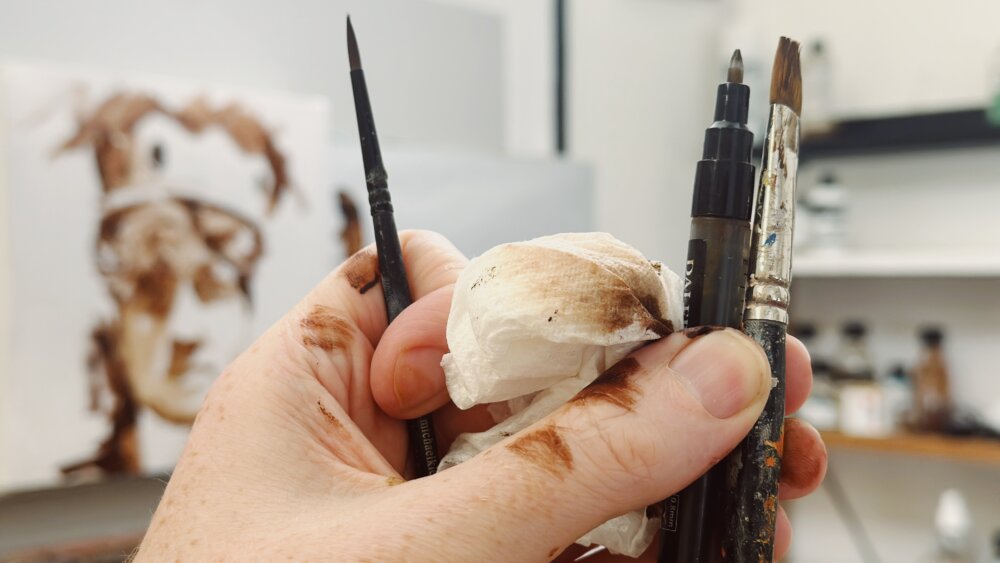
The act of creating a portrait is an emotional one.
It goes far beyond capturing a mere likeness; it delves deep, exposing their character and yours.
A finished portrait may exude confidence and calm, but the journey of its creation is often a complex maze of doubts, fears, and self-criticism for the artist.
We can overthink the composition or the medium choice. Then we question, maybe we should have studied drawing a little longer. Maybe we should start when we’ve got more time?
These are often (well-constructed) excuses based on two main insecurities.
- The fear we won’t do the subject justice
- The fear of social ridicule
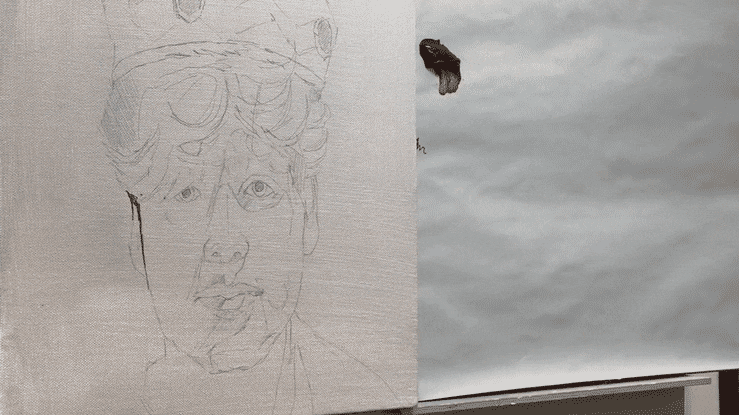
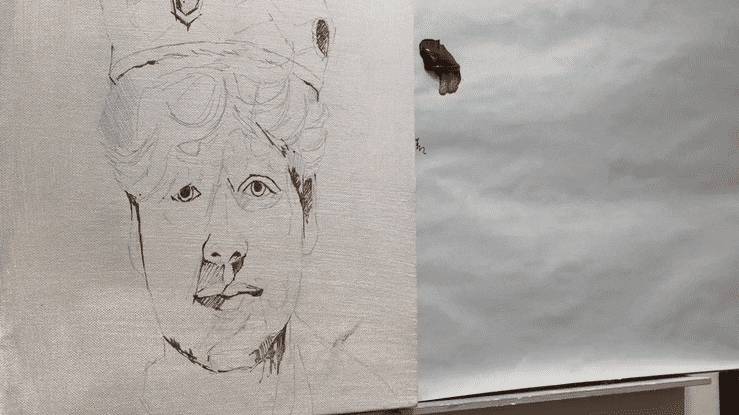
I’ve just started a portrait of my nephew, and before I began the process, those same butterfly feelings bubbled up.
The first fear is dealt with more logically now, compared to when I was first starting out.
I still question, ‘What painting method will I use?” “Will it look like him?” “Will I overwork it?
But it’s the second fear that seems to hit me the most and as hard.
Will someone else judge your portrait attempts and deem you a ‘bad’ artist?
Probably.
But I’ve learnt this can happen if you’re a professional artist with years of painting experience behind you as easily as if you’re an absolute beginner.
On your first driving lesson, if someone judged you as being a ‘bad driver’, you would have laughed at them and said, ‘I know! It’s the first time I’ve ever tried.’
No blame, no shame. That’s the essence of successfully progressing as a portrait painter.
The Challenges
If you’ve overcome the fear of actually starting, painting a portrait comes with different challenges to other subjects.
First, there is the technical challenge of creating a three-dimensional form on a two-dimensional surface.
Then, the colour mixing challenge of expressing realistic skin tones, hair and features.
And finally, the realism challenge of creating a likeness to the sitter.
So, how can I help?
Here are three solutions that I’ve found can really help overcome insecurities when painting portraits:
1. Build Confidence Through Practice:
One of the most effective ways to combat insecurities is through consistent practice.
Many of my paintings are just for personal use and not intended for public viewing. The more I practice, the more my skills will improve, leading to increased confidence in my abilities.
2. Focus on the Process, Not Just the Outcome:
Insecurities often stem from fixating on the end result.
Focus towards enjoying the creative process itself. Self-expression, exploration, and experimentation. When the process becomes the primary goal, you can find fulfilment in your work regardless of external judgments.
3. Seek progress, not perfection:
Imperfections are a natural part of the creative journey, and learning any new skill will be a series of jumps in progress and self-reflection on how much there still is to learn.
When following a course, the aim is just to follow the steps.
“I can’t see a way through,” said the boy.
Can you see your next step?
Yes.
Just take that said the horse.”
I have two portrait courses that can help guide you through.
1: Acrylic Portrait Course (suitable for beginners)
The focus of this course is simple, natural colour mixes to help you create realistic skin tones.
The concern for many beginners is that portraiture feels too challenging and would be above their current skill level. So I’ve designed these portrait courses to be as user (and fear) friendly as possible.
We learn about lighting, colour theory and create colour swatches before even starting the portraits. There are line drawings to work from, and we start slow with just a four-colour painting palette.
(You can see some student results here.)
So, will the course be a challenge?
Yes
Will you feel like a ‘portrait imposter’
You will, but only until you start painting.
If you stick to the lessons and follow the steps, you’ll gain huge confidence in what is achievable.
- Creating Realistic Skin Tones, learn the secrets behind mixing and applying skin tones that appear natural and lifelike.
- Gain insights into the nuances of capturing subtle transitions in the skin, from shadows to highlights.
- Material recommendations.
- How to master the Zorn Palette, the amazing power of a limited palette.
- Colour theory, colour strings, and palette choice.
- Lighting theory to create accurate colour mixes for your portraits.
- Paint application & brushwork, from scumbling to palette knife.
- Poster study using a more direct Alla Prima style.
- Includes over 4 1/2 hours of video instruction, three self-study painting assignments, materials guide PDF, and downloadable reference images to paint from.
2. Oil glazing portrait course (suitable for intermediate or have some drawing experience with portraits)
This course is a more advanced portrait course teaching a classical painting approach based on multiple layers of painting (called in-direct painting)
It needs patience and more time commitment.
It’s a method that seems counterintuitive. Paint your portrait first in black and white and then apply colour on top.
The art of combining the classical technique of grisaille (black and white) with the mesmerizing effects of colour glazing creates stunningly lifelike and captivating portraits.
- Mastering Grisaille Technique: Learn the foundation of grisaille painting, using monochromatic tones to create a strong value structure and achieve realistic shading.
- Creating your own painting medium (traditional and modern materials)
- Completing a value study painting using the planes of the face.
- Discover the art of colour glazing, layering translucent colours over your grisaille underpainting to achieve luminosity and rich tonal variations.
- Explore the magic of transparent and semi-transparent glazes to enhance the vibrancy & learn about glazing mediums.
- Completing two head portrait paintings.
- Includes over 6 hours of video instruction, two self-study paintings, materials guide PDF, and downloadable reference images to paint from.
P.S. – If you have done either of the portrait courses and have any encouraging words or testimonials for other artists who might be at the point where you were before starting the course, drop me a comment below!


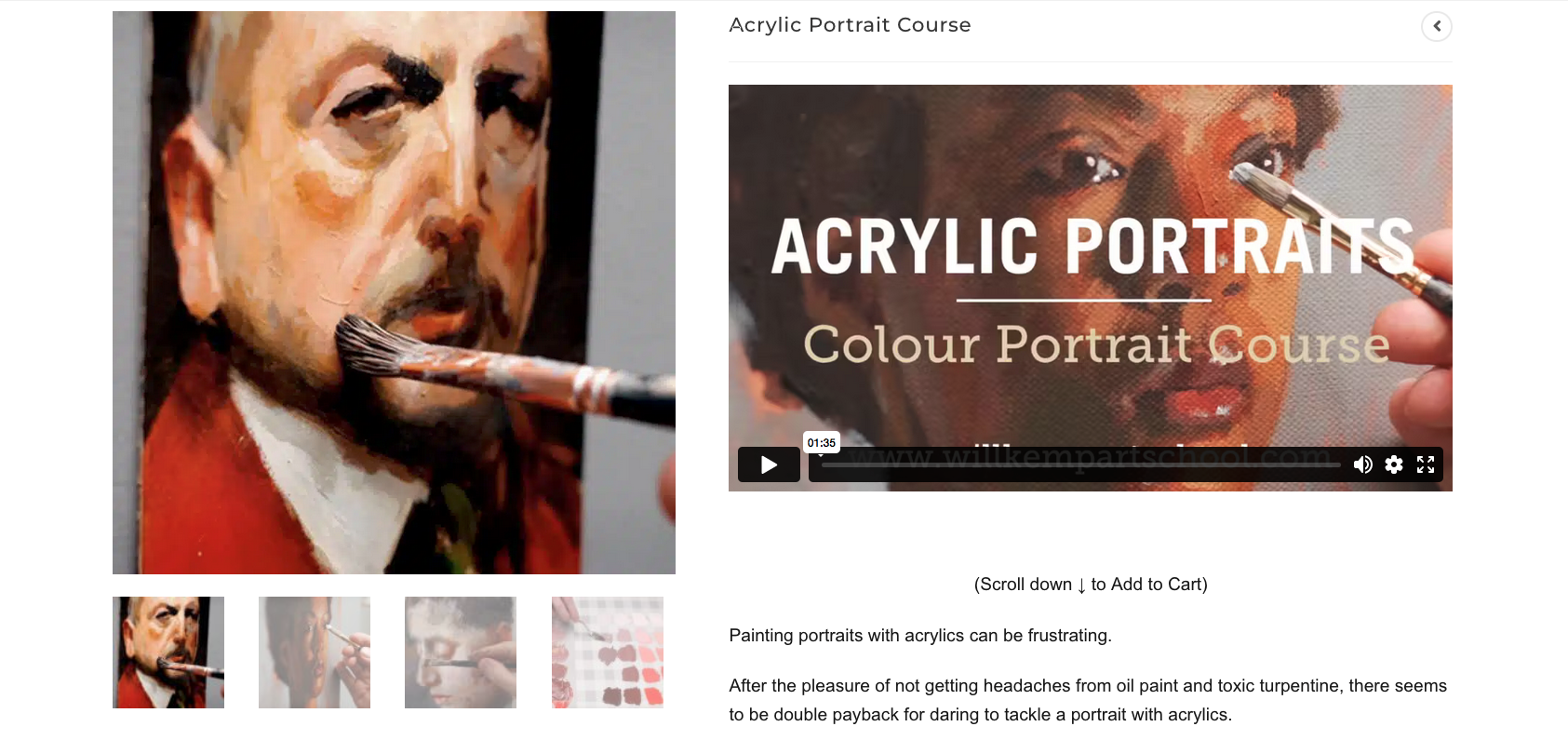
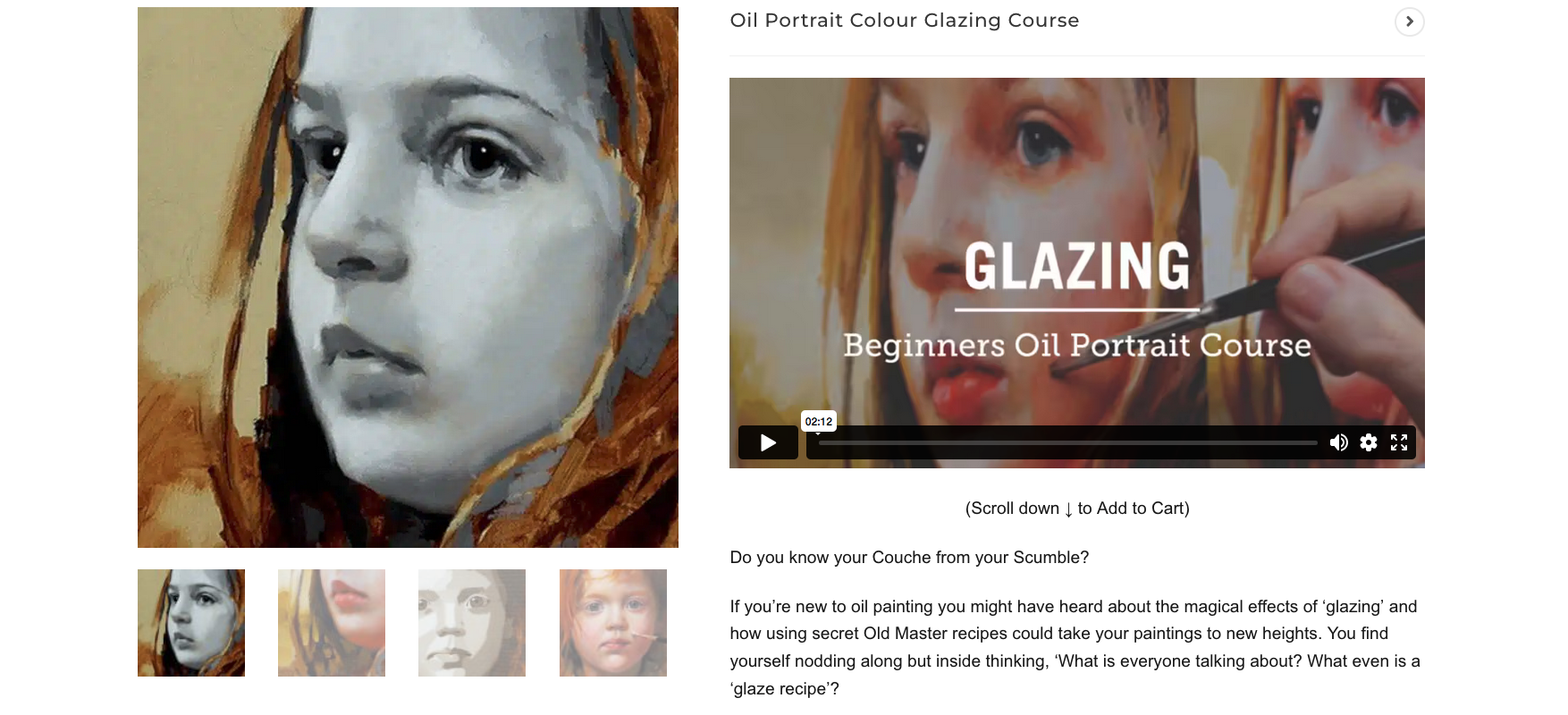
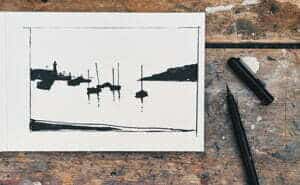

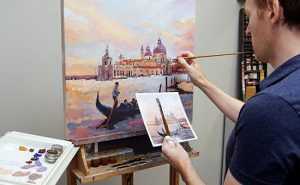
I have taken both of these courses and they are fantastic and a must for any person who wishes to attempt portraiture. The Acrylic Portrait course will give you a world of knowledge about the Zorn palette and how to mix convincing skin tones. The Oil Portrait Glazing course delves deeply into the art of the “grisaille” painting and how to layer the skin tones on top of a black and white painting with glazes. I use this method now when I paint portraits because it is such a helpful building block toward a beautiful final product.
Fantastic to hear Lynn, summed up perfectly! so pleased you found the courses helpful.
Will
I love portrait drawing but I already have think I am not sure of what to do especially with colours I am a complete amateur when it comes to colors
Hey Pauline, that’s a gret position to be in for portraits. Having the drawing skills will really help when checking features as the painting progresses. Starting with black and white portraits can be a good place to start to translate the drawing elements into paint first before introducing colour.
Will
I took the acrylic portrait course (5 years ago) and it was the springboard I needed to get my color mixing for portraits figured out! The zorn palette is a great limited palette and you can always tweak your colors once you get a basic understanding from using the zorn palette and this class!
I’m partway through a 100 head challenge (painting 100 portraits) and have done several other portrait paintings. Color mixing is much much easier for me now than before and I credit Will’s class for helping me figure it out!
My website is http://www.katebattleartist.com if you’re interested in seeing some of my work.
Wow Kate, looking amazing! so pleased you found the course helpful. Thanks for sharing your works, love the off centre gazes.
Will
I took the Acrylic Portrait course last year and it was brilliant. Will’s videos and supporting documents are very well made, and his explanations and demonstrations are clear, easy to follow and very engaging and interesting. I learned so much through this course, including how to identify and mix colours and build up each portrait from the initial outline drawing, adding tonal values, applying blocks of colour, refining and adding detail, and adding texture. In the course Will also shows you how to add mediums to enhance the behaviour and properties of the paint, and the overall finish of the painting. I highly recommend this course to anyone wanting to learn how to paint portraits and use acrylics.
You did amazingly on the course Martin, so pleased you found it helpful. Thanks for your kind words on the teachings.
Will
Will, I have taken the acrylic portrait course and had great results. The color techniques have really made a huge difference in painting portraits, saving me so much time and struggle! Thank you! I would love to take the Oil Portrait Glazing Course, but wonder if these techniques lend themselves to acrylics?
Hey Linda, glad you found the acrylic course helpful in your paintings.
Mmm, it’s a tricky one. In theory, yes. Although in practice, I wouldn’t recommend this particular course with acrylics.
It’s all about a balance between having enough time to soften and blend the modeling of the face without feeling like your glazing layers are taking weeks and weeks to complete.
Due to the speed of the drying of the acrylics, they could appear to be the perfect choice of paints for glazing, however, for this method it’s easier to have more blending time to model the Grisaille underpainting accurately.
That’s not to say I don’t use acrylics at all on the course, on the coloured ground and for some sections of the hair I demonstrate how you can incorporate acrylics into your underpainting, but sticking to oils for the Grisaille of the face will give you the best results.
If you work small and paint quickly, you could adapt the techniques to acrylics, but you would get more realistic results, more easily with oils.
Hope this helps,
Will
I was a novice painter who started from scratch by paining that ‘Cherry’ that Will taught me how to paint, for free, on youtube. I then did most of Will’s excellent courses until I came to… portraits!! I was 70. By the time I was 75 I was painting portraits professionally … purely using the techniques taught on Will’s portrait course.
I stopped painting for years whilst I became a 24/7 fulltime care for my late wife. I am now mentally ready to face painting again and will do the portrait courses once again, safe in the knowledge that they will get me back to where I was. I am now 85 … it’s never too late!
Hey John, thank you so much for sharing your incredible journey. It’s truly inspiring to hear how you started as a novice painter and through dedication and guidance, you were able to paint professionally. Your story demonstrates that passion and determination have no age limit!
I’m sorry to hear about the loss of your wife and the pause in your painting journey. Taking care of a loved one is an honorable and selfless act. It’s wonderful to hear that you’re mentally ready to immerse yourself in painting once again.
Wishing you all the best as you dive back into painting!
Will
Thanks professor will Kemp for the instructions